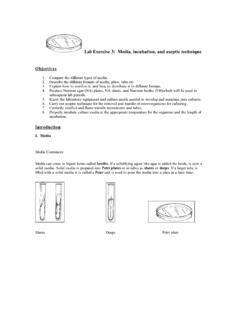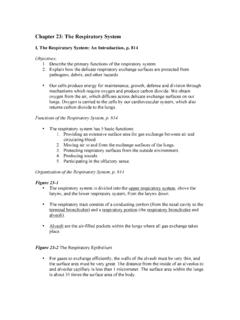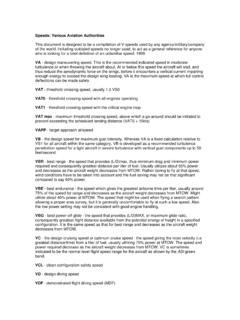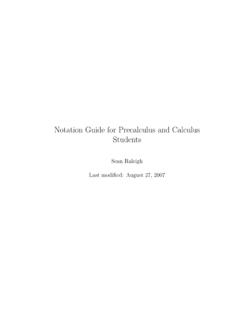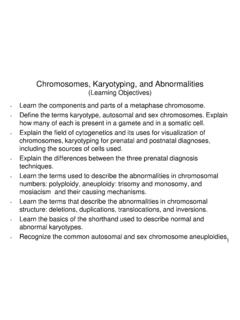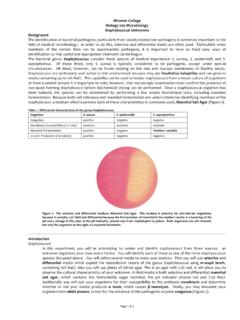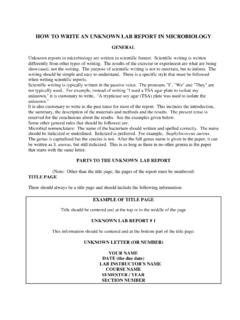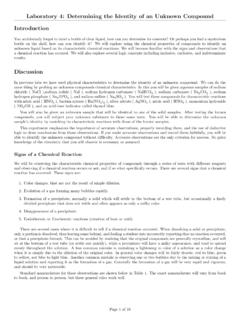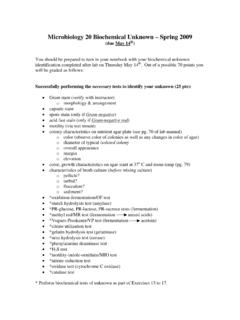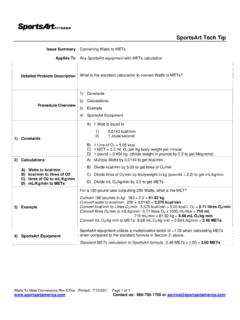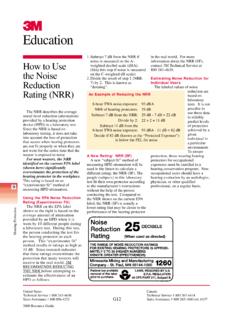Transcription of Major Unknown Report - San Diego Miramar College
1 Microbiology 205 ^ Major Unknown Report Suzanne Ricca - Lab #22 Gram (+) Unknown #13 Bacillus subtilis Gram (-) Unknown #13 Proteus mirabilis Isolation and Identification of Gram (+) Organism #13 Bacillus subtilis Unknown organism was streaked from a mixed broth onto both TSA and BHA plates in an attempt to isolate pure colonies for testing. Although growth was best on the TSA plate, the Gram(+) organism was unable to be isolated because of overgrowth of the Gram(-) organism. The plate showed areas of tiny pinpoint colonies surrounded by cloudy areas, indicating the presence of the Gram(-) organism throughout the plate.
2 This was confirmed with gram staining of the pinpoint colonies which showed the presence of both organisms. Another streak was done on a PEA plate in an attempt to inhibit the growth of the Gram(-) organism enough to isolate the Gram(+). One large circular colony grew on the PEA plate. Gram staining indicated the presence of long pinkish rods with circular purple spots inside the cells. The presence of a faint smaller shape throughout the slide was also noticed, and thought to be spores. Spore staining was inconclusive and the PEA plate was returned to the incubator for further aging.
3 Two TSA slants were inoculated to produce working samples, as well as a motility deep and FTM broth. Gram staining of the TSA working slant showed the same long pinkish rods with purple dots as well as faint shapes in the background. The FTM showed a facultative anaerobe and the motility test showed the organism to be motile. Another spore stain of the PEA plate remained inconclusive and the plate was returned to the incubator. In the likelihood the organism was in fact a spore former and therefore in the Bacillus genus, a mannitol broth was inoculated to begin to differentiate among the Bacillus species.
4 A final spore stain was done on samples taken from the PEA plate as well as the working slant. Although there was no change to the stain from the PEA plate, fortunately the sample from the working slant produced the appearance of spores and confirmed the genus Bacillus. Unfortunately the faint background shapes were not the actual spores but short rod-shaped cells and indicated the continuing presence of the Gram(-) organism. Since the motility test and FTM test were done with the organisms still mixed, they are not able to be used. The mannitol test (read on ) appeared negative, indicating neither organism is a mannitol fermenter, so that test is still good.
5 A sample from the working slant was streaked onto another PEA plate to try to further inhibit the Gram(-) growth and isolate the Bacillus. - There was heavy growth throughout the new PEA plate with a few tiny pinpoint colonies but they were not isolated form the rest of the growth. It did not appear as if the second organism was still present however and this was confirmed by doing a gram stain from the growth at the end of the streak. The long pinkish rods with purple spots inside the cells were still present, but no smaller rods were present and the Bacillus seemed to finally be isolated.
6 Two new slants were inoculated to produce new working samples. Since the mannitol test was already done and negative, the species B. subtilis is eliminated. A MRVP broth was inoculated to differentiate between B. megatarium (VP-), B. sphaericus (VP-), B. cereus (VP+) and B. thuringiensis (VP+). VP test was positive. To differentiate between B. cereus and B. thuringiensis a blood agar plate was streaked to determine strength of hemolysis, since the species are similar in almost every other way. They are both hemolytic but B. cereus is stronger. Samples of known B.
7 Cereus and B. thuringiensis were also streaked on the plate to compare with the Unknown . The hemolysis result was not consistent enough with either known species to be definitive. It looked most like B. thuringiensis but the Unknown growth had raised wrinkled areas and appeared unique enough to be a separate species. A problem with the mannitol test is suspected and another mannitol broth was inoculated to retest for B. subtilis. The mannitol test was not a strong positive, but still clearly positive. The broth turned yellow-orange at the top although remained red toward the bottom and there were a few bubbles in the tube.
8 Most of the growth was at the top indicating the possibility of an aerobe rather than facultative anaerobe. Since the VP test is already done and positive, Bacillus subtilis is confirmed. Mannitol retest (+) VP (+) Hemolysis: Unknown in Middle Media Table Test Purpose Result Gram stain Determine morphology and arrangement Gram positive, long pinkish rods (bacilli) with purple dots Spore stain Differentiate gram positive bacilli between spore formers and non-spore formers Spore former, indicating Bacillus, also showed gram negative organism still present FTM broth Determine oxygen requirements and differentiate Bacillus species Facultative anaerobe (growth throughout)
9 , may not be accurate due to gram negative Motility Deep Determine motility and differentiate Bacillus species Motile, consistent with all possible Bacillus species PEA Plate Inhibit gram negative growth and isolate gram positive Gram positive isolated, confirmed with gram srain Mannitol broth (Mannitol Fermentation) Differentiate Bacillus between fermenters and non-fermenters Negative (red) indicates B. cereus, B. megatarium, B. sphaericus or B. thuringiensis MRVP (Acetoin production) Use VP test to differentiate mannitol non-fermenters VP positive (red) indicates B.
10 Cereus or B. thuringiensis Blood Agar Hemolysis Streak Unknown between given samples of B. cereus and B. thuringiensis to compare strength of hemolysis Growth inconsistent with either species as Unknown exhibited unique contoured wrinkles, contamination of mannitol test suspected Mannitol broth (Mannitol fermentation) Retest mannitol fermentation to differentiate VP positive species B. subtilis and B. megatarium Weak Positive (yellow-orange with some red remaining), confirms Bacillus subtilis Habitat & Lifestyle Bacillus subtilis Generally considered a ubiquitous organism, B.
